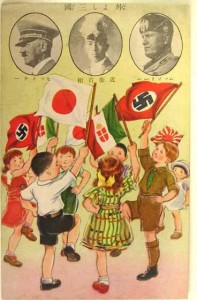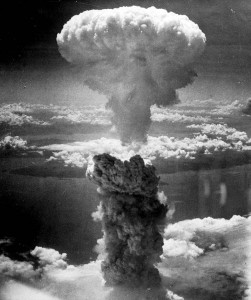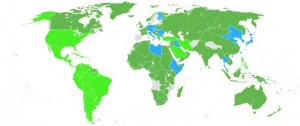The Axis Powers were one of two major military alliances during World War II. They consisted of Germany, Japan, and Italy. The opposing side, consisting of many countries including Britain, France, and Poland, was known as the Allies. Although the Axis nations did not develop cooperating institutions in regards to foreign policy like the Allies did, they did share a few common causes. They were all in favor of the elimination of communism in the Soviet Union, territorial expansion, and the end of the restrictions cited in the Treaty of Versailles.
Background
 By the mid 1930s, the post-WWI restrictions on military growth had been deemed unacceptable by Nazi Germany and its ally, fascist Italy. The Second World War began in 1939, with Hitler’s invasion of Poland. The Axis powers united to take on the Allied forces and, in July of 1937, the war spread to the Pacific with the Japanese invasion of China.
By the mid 1930s, the post-WWI restrictions on military growth had been deemed unacceptable by Nazi Germany and its ally, fascist Italy. The Second World War began in 1939, with Hitler’s invasion of Poland. The Axis powers united to take on the Allied forces and, in July of 1937, the war spread to the Pacific with the Japanese invasion of China.
The Axis alliance grew out of the Anti-Comintern Pact, signed by Germany and Japan to refute Communism. Italy joined this pact in November of 1937. Late in the same month, Germany signed another treaty with Japan, promising cooperation against the Soviets. In May of 1939, Italy and Germany agreed to the “Pact of Steel,” a political and economic alliance dedicated to cooperation and a union of policies between the two countries. This agreement was supplemented by the Tripartite Pact, which unified the three Axis nations on September 27, 1940.
The Growth of Alliance
In the summer of 1941, Germany and a number of other European Axis powers launched a surprise attack on the Soviet Union. Hitler realized that for this attack to succeed, Germany would require substantial contributions in terms of troops, rights of passage, and raw materials. He therefore exerted considerable pressure on Hungary, Romania, and Slovakia, who were offered economic aid in return. In addition, Romania was offered a portion of the Russian territory that would be occupied by Germany.
In the winter of 1940, Italy invaded Greece. The attempt ended in failure with Italy retreating back to Albania, an outcome which concerned German leadership who felt that the alliance’s Balkan flank was left dangerously weak as a result. Greece entered the war and won victories in the north and in Albania. As a result, British troops were able to cut off access to the crucial oil fields in Romania.
Further Expansion
Hungary agreed to join the Axis Powers and entered into the Tripartite Pact on November 20, 1940. Romania followed three days later, hoping that supporting the Axis powers and the maintaining regular deliveries of oil would help end Soviet threats to its own territorial integrity. Slovakia joined the alliance on November 24th. However, as it was almost completely dependent on Germany for its continued existence, it had little choice.
Yugoslavia, being largely undecided, was Greece’s tentative ally. Bulgaria was hesitant to join the Axis powers, as its government did not want to engage in battle with the Soviet Union. Therefore, Germany proposed a compromise in which the Bulgarians would provide support for the Axis cause in everything except the invasion of Russia. Bulgaria deemed this offer sufficient and joined the Axis in March of 1941. Yugoslavia followed reluctantly later that month, when Germany had accepted that it could remain neutral with Greece. Just two days later, the Yugoslav government was overthrown, and four Axis nations divided its territory among themselves.
The Axis invasion of the Soviet Union was launched on June 22, 1941. Four days later, Finland joined the fighting against the Russians, hoping to recapture the lands it had lost during the War a year and a half previously. On December 7, 1941, Japan launched a surprise attack on the American fleet at Pearl Harbor, effectively bringing the United States into the war. The Axis powers in their turn declared war on the U.S., transforming the previously largely Europe-based conflict into a true world war.
Fall and Aftermath
 Many historians cite the Battle of Midway as one of the major turning points in the war, as the American Navy met and defeated the Japanese in the middle of the Pacific. With many of the Axis powers now fighting on multiple fronts, the Allied nations were able to return to the offensive. The first Axis nation to surrender was Italy in September of 1943, after dictator Benito Mussolini had been deposed. August 1944 saw the dictator Ion Antonescu of Romania similarly overthrown, at which point the newly instated government began supporting the Allies. Bulgaria tried to offer armistice terms to the Russians but was rebuffed and surrendered in early September. Finland, however, did conclude an armistice agreement with the Soviets on September 19th.
Many historians cite the Battle of Midway as one of the major turning points in the war, as the American Navy met and defeated the Japanese in the middle of the Pacific. With many of the Axis powers now fighting on multiple fronts, the Allied nations were able to return to the offensive. The first Axis nation to surrender was Italy in September of 1943, after dictator Benito Mussolini had been deposed. August 1944 saw the dictator Ion Antonescu of Romania similarly overthrown, at which point the newly instated government began supporting the Allies. Bulgaria tried to offer armistice terms to the Russians but was rebuffed and surrendered in early September. Finland, however, did conclude an armistice agreement with the Soviets on September 19th.
In March 1944, Germany occupied Hungary in an attempt to hold the country’s alliance and support. As a result, the Hungarians never surrendered to the Allies, and a state of war existed there until April of 1945, when the Soviet army finally drove the pro-Axis resistance across the country’s western front into Austria. The fighting in Slovakia ended when its capital Bratislava fell in the same month.
The Croatian military continued to resist Marshal Josep Tito’s partisans until late in April, after which Germany was the only European member of the Axis alliance still continuing to resist the Allies. Hitler committed suicide in his Berlin bunker on April 30, 1945. A week later, his replacement as leader, Admiral Doenitz, signed the unconditional surrender of all German forces. Therefore, Japan was the final Axis power to remain a combatant. It continued to resist the Allies for months until the United States dropped an atom bomb on Hiroshima on August 6th of that year. Two days later, another bomb was dropped on Nagasaki. The damage caused by these new weapons was catastrophic and their use during the war is still considered controversial today. Following these attacks, Emperor Hirohito formally surrendered on September 2, 1945.
